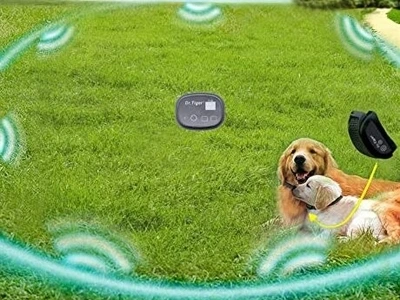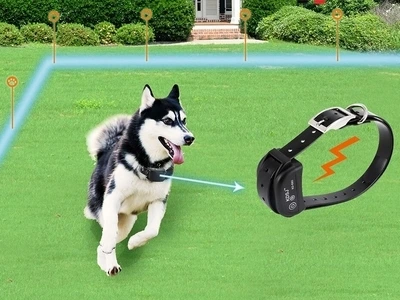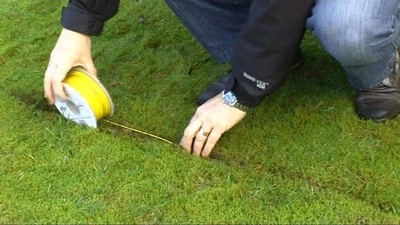Depending on how your yard is set up and where you place your transmitter, some things can interfere with how well your wireless dog fence works to keep your fur pal safely at home.
Metal roofs or other large metal objects, aluminum siding, large trees or bushes, a steep hill, neighboring fences, other electrical objects, or even walls could all interfere with a wireless dog fence.
Let’s take a look at wireless dog fence interference, why it’s a problem, and what you can do to minimize it.
Things That Create Wireless Dog Fence Interference
The most common causes of wireless dog fence interference are:
- Metal roofs
- Metal sheds
- Large metal appliances
- Parked cars
- Cement walls
- Aluminum siding
- Heavy forestation
- Steep hills
Sources of Wireless Dog Fence Interference in Detail

Since an invisible fence relies on the transmitter sending out AM signals to both the boundary line and your dog’s receiver collar, anything that might disrupt those electrical signals could be a problem.
There are many factors both in your yard and in your house that could potentially interfere with a wireless fence.
Metal Roofs and Objects
As metal is a conductor, it can cause electrical signals to go haywire.
If your transmitter is anywhere near a metal roof, signals from that transmitter could bounce off the metal roof.
Also, just like the metal roof, any large metal object, such as a shed, in or around your yard could cause the signal to jump around.
This makes it extremely difficult to impossible to set the boundary and get it to stay exactly where you want it. It can also make the fence not work at all.
Aluminum Siding
Aluminum siding on your house, garage, or outbuilding could also serve as a roadblock to the fence’s signal, blocking the boundary line, or causing signals to your dog’s collar to bounce off.
Large Trees or Thick Shrubbery
Any kind of large, dense object will serve as a barrier to the fence’s electrical signal.
While small bushes and trees are probably fine, dense bushes or large trees could provide enough of a block to decrease or even eliminate the fence’s signal.
Thick shrubbery around the perimeter of the property is okay as long as the fence is set to land inside the shrubbery so the signal isn’t disrupted by the plantings.
However, heavy shrubbery between the transmitter and fence perimeter can disrupt the signal.
Steep or Hilly Terrain
Wireless fences do not handle rapid elevation changes well.
A steep hill in between your boundary line and the transmitter could cause some problems in how the electrical signals are relayed.
The fence works best when it is at or very close to the same plane as the ground that it’s covering with the wireless signal.
Neighboring Wireless Fences
If your neighbor has a wireless fence, it could potentially interfere with yours.
When the signals get crossed, receiver collars could end up connecting to the wrong transmitter, and your dog and your neighbor’s dog could actually cross into each other’s yards.
This can be avoided by ensuring that your invisible fence frequency is a different frequency than your neighbor’s fence.
Heavy Wall Construction
This especially applies to concrete, brick, or stone walls. Walls made out of these materials are thick enough and dense enough to block the signals.
Also, the signal may get lost if it has to travel through multiple walls. Always install the transmitter on or near the outermost wall of the dwelling to transmit the signal.
You can’t place the transmitter in the open because it isn’t waterproof.
If you choose to place it in a waterproof box, make sure the box has proper ventilation or the transmitter unit will overheat.
Other Large Metal Objects
Metal sheds, refrigerators, freezers, toolboxes, and metal shelving can all cause interference or block the signal from your wireless fence transmitter.
A metal outbuilding can cause a “break” in the invisible fence that will have to be blocked some other way.
When choosing the location for the wireless fence transmitter, be sure to place it several feet away from any other large metal objects in the area.
Don’t install it on or very near metal shelving or toolboxes.
Here’s a quick 1-minute video that explains how different metal objects can change the shape of or disrupt the wireless fence signal in your yard.
What Happens During Wireless Fence Interference?
When obstacles get in the way of a wireless fence, it causes interference with the fence.
The signals can bounce off these obstacles, leaving you with a few different potential problems:
- Your boundary line could jump around, moving the fence line from where you intended it to be.
- Your dog’s receiver collar could receive the wrong signals and deliver shocks even when he’s in the yard where he’s supposed to be.
- Your dog could escape the yard because the boundary line isn’t being enforced in one area or the block could make the fence completely dead.
Those are all situations you need to avoid for the safety of your dog!
If you can’t avoid interference well enough to keep your dog safe in the yard, you need to opt for one of the best in ground dog fence options.
These are easy to install, work the same as wireless fences, and don’t have any trouble with building or landscaping interference.
How deep is an invisible fence buried? Here’s how deep to install your fence!
How to Eliminate Wireless Fence Interference
So how exactly do you eliminate fence interference from objects in your yard?
There are a few steps you can take to get rid of, or at least minimize this interference:
- Consider moving any large metal objects in your yard. For example, if you have a metal shed, think about moving that out of range of your wireless fence if possible.
- Avoid placing your wireless fence around dense bushes or large trees.
- Choose the flattest place in your yard to set up your wireless fence.
- Check with your neighbors about whether they have an invisible fence. If they do, you may need to set up your boundaries in a way that the fences won’t interfere. Set your fence to a different frequency so both fences will work.
- If you place your transmitter inside your house, put it near a door or a window, with few walls in between the transmitter and the yard.
- Keep all metal objects or electrical objects at least 3 feet away from the transmitter.
By following these tips, you will be able to minimize the interference that may happen with your fence.
See our related article, Where Do You Put a Dog Fence Transmitter Box? for a more in-depth guide to placing your transmitter correctly!
What if I Can’t Eliminate Wireless Fence Interference?

Worst case scenario, if you can’t eliminate the chance of interference, you do have an alternate fence option.
We recommend purchasing one of the best underground dog fence options instead of a wireless one.
This fence will not be affected by interference, because it doesn’t depend on electrical signals coming from a long-distance transmitter.
If you have anything in your yard that could interfere with a wireless fence, a wired fence will be much more reliable.
How Does a Wired Invisible Fence Work?

A wired fence works by burying a wire underground around the perimeter of the yard. You can get a larger gauge wire (smaller number) to get a stronger signal where needed.
Just like a wireless fence, your dog will wear a receiver collar that will beep or deliver shocks if your dog approaches or crosses the underground wire.
If you choose to go with the wired fence route, there are a few things you should know.
- Wired fences are more work to install since you have to bury the wire about 1 to 3 inches underground.
- Once buried, the wire usually works reliably for years. However, if it does get a break in it, you’ll have to splice in a new piece of wire around the break.
- Wired fences can be fully customized to the shape of your yard, but you’ll have to protect them across walkways or driveways to avoid breaking the wire over time.
- You can buy extra wire to have a bigger yard for your pup – up to 5 acres on a single transmitter.
- You can lay the wire wherever you want. Need to fence off a pool? No problem; just bury the wire around the perimeter of the pool, and your dog will not be able to access the pool.
Wired fences take a bit more time to install, but that time cost can even out if you’re struggling to eliminate wireless transmitter interference.
It’s arguably easier, cheaper, and takes less time to run a buried wire than it does to move or replace a shed, roof, or create a new parking area for cars.
All types of invisible fencing require that you train your dog to stay inside the fence and not run away.
Read More: Which is Better Wired or Wireless Dog Fence? We put these two fences head-to-head to help you find the right system for your and your dog’s needs!
Final Thoughts
We love using wireless dog fences for urban and suburban yards with typical wood-frame and asphalt-shingle housing.
They’re so quick and easy to set up, and the perimeter is plenty for a small yard.
While gutters can change the shape of the wireless fence, they can’t disrupt it altogether.
Test the fence in all areas before putting the collar on your dog and training so you know exactly where the “safe” areas are.



